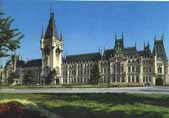The
beginning of the 19th century represented the "golden age"
of mechanical music. Technical inventions were abundant and so were
the reading systems as well (perforated cardboards and paper rolls)
which determined most of the music instruments to become automatic:
mechanical pianos, orchestrons of all kinds. These instruments were
functioning with a system of pneumatic reading (pressured air or rather
depressured air produced by the passage of the roll over the orifices).
Some of the most complex music automata are the pneumatic pianos,
generally named pianolas.
The first pianola
was made by the American Edwin S. Votey in 1895 whewn he founded Aeolian
Company. Pianolas enjoyed a great success being commercialized in
the U.S.A. starting from 1897 and in Europe from 1899. The German
version of the pianola was the "phonola” produced and sold
in thousands of copies by the company "Ludwig Hupfeld A.G.”
The electrically driven pianola Hupfeld Dea of the collection of the
Science and Technique Museum is a music automaton which is attached
to a piano or a cottage piano. When the button is pressed, a mercurium
switch puts on the electric engine of continuous current which controls
the main bellows in pneumatic system. The reading of the perforated
paper is done by a metallic pipe named "the flute of Pann",
foreseen with 106 holes which correspond to the number of keys of
the piano and the START/STOP buttons and foreword.
Another type
of automatic piano is the cottage piano - pianola used for direct
and automatic interpreting. The museum collection includes such a
Hupfeld Universal A automaton. At the basis it has a cottage piano
of an exceptional quality, with an integrated mechanism for the rolls.
The pneumatic system is controlled by an electric engine which transmits
the rotation movement to a wheel. The same wheel can be rotated also
by a crank. Another automaton of the museum collection is the orchestron
Hupfeld Phonoliszt-Violina, whose name comes from the great piano
player Franz Liszt. Hupfeld Phonoliszt Violina uses three violins
mounted vertically and whose playing is determined by a circular bow
of 1300 threads of horse hair. A very sensitive pneumatic system determines
a higher or lower pressure of the three violins on the rotating bow,
according to the programme on the roll of perforated paper. The small
bellows replace the violin player's fingers, pressing on the strings
so to obtain the necessary notes. Each violin has a single string.
The piano can be driven alone or together with the violins. It controls
38 accompaniment keys with 12 high notes (one octave) in extension.
The whole pneumatic system is controled by an electric engine of continuous
current. The Hupfeld Factory sold this type of instrument for 20 years
without any competitor. It seems that nowadays there still exist about
60 items of this time worldwide.

